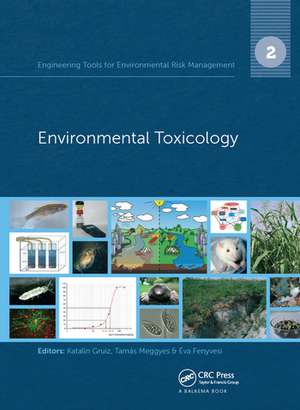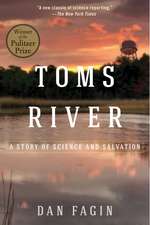Engineering Tools for Environmental Risk Management: 2. Environmental Toxicology: Engineering Tools for Environmental Risk Management
Editat de Katalin Gruiz, Tamas Meggyes, Eva Fenyvesien Limba Engleză Paperback – 30 iun 2020
Environmental risk management has two subsections: risk assessment and risk reduction. Environmental risk, to a large extent, arises from the adverse effects of chemicals and contaminated land; that is why measuring and testing these effects plays a key role in risk management.
“Environmental Toxicology” deals with direct measurement of adverse effects of pure chemicals or environmental samples. This book has therefore been created specifically for engineers and gives a general overview of environmental toxicology. It provides an overview of hundreds of standardized and nonstandardized, generic and site-specific, conventional and innovative, animal and alternative test methods, and demonstrates how to apply these results to the regulation and management of environmental risk. In addition to human, aquatic and terrestrial methods for measuring toxicity, new trends in environmental analytics and the integration and complementary use of chemical analyses and the testing of effects are described.
Bioavailability and accessibility as key parameters are detailed and the interactive and dynamic characterization of contaminants in soil is introduced. Emphasis is placed on the evaluation and interpretation of environmental fate and adverse effect data as well as the simulation of environmental processes and effects in microcosms and mesocosms.
| Toate formatele și edițiile | Preț | Express |
|---|---|---|
| Paperback (2) | 325.23 lei 6-8 săpt. | |
| CRC Press – 30 iun 2020 | 325.23 lei 6-8 săpt. | |
| CRC Press – 30 iun 2020 | 326.00 lei 6-8 săpt. | |
| Hardback (2) | 887.39 lei 6-8 săpt. | |
| CRC Press – 8 aug 2014 | 887.39 lei 6-8 săpt. | |
| CRC Press – 27 apr 2015 | 1138.37 lei 6-8 săpt. |
Preț: 326.00 lei
Preț vechi: 363.48 lei
-10% Nou
Puncte Express: 489
Preț estimativ în valută:
62.38€ • 65.21$ • 52.72£
62.38€ • 65.21$ • 52.72£
Carte tipărită la comandă
Livrare economică 06-20 martie
Preluare comenzi: 021 569.72.76
Specificații
ISBN-13: 9780367575892
ISBN-10: 0367575892
Pagini: 596
Dimensiuni: 174 x 246 mm
Greutate: 1.1 kg
Ediția:1
Editura: CRC Press
Colecția CRC Press
Seria Engineering Tools for Environmental Risk Management
ISBN-10: 0367575892
Pagini: 596
Dimensiuni: 174 x 246 mm
Greutate: 1.1 kg
Ediția:1
Editura: CRC Press
Colecția CRC Press
Seria Engineering Tools for Environmental Risk Management
Public țintă
PostgraduateCuprins
1. Environmental toxicology –A general overview 2. Fate and behavior of chemical substances in the environment 3. Human toxicology 4. Aquatic toxicology 5. Terrestrial toxicology 6. Advanced methods for chemical characterization of soil pollutants 7. Bioaccessibility and bioavailability in risk assessment 8. Microcosm models and technological experiments 9. Data evaluation and interpretation in environmental toxicology
Notă biografică
Katalin Gruiz is Associate Professor at Budapest University of Technlogy, Budapest, Hungary.
She graduated in chemical engineering at Budapest University of Technology and Economics in 1975, received her doctorate in bioengineering and her Ph.D. in environmental engineering. Her main fields of activities are: teaching, consulting, research and development of engineering tools for risk-based environmental management, development and use of innovative technologies such as special environmental toxicity assays, integrated monitoring methods, biological and ecological remediation technologies for soils and waters, both for regulatory and engineering purposes. Prof. Gruiz has published 35 papers, 25 book chapters, more than hundred conference papers, edited 6 books and a special journal edition. She has coordinated a number of Hungarian research projects and participated in European ones. Gruiz is a member of the REACH Risk Assessment Committee of the European Chemicals Agency. She is a full time associate professor at Budapest University of Technology and Economics and heads the research group of Environmental Microbiology and Biotechnology. Tamás Meggyes is Research Coordinator in Berlin, Germany.
He is specialising in research and book projects in environmental engineering. His work focuses on fluid mechanics, hydraulic transport of solids, jet devices, landfill engineering, groundwater remediation, tailings facilities and risk-based environmental management. He contributed to and organised several international conferences and national and European integrated research projects in Hungary, Germany, United Kingdom and USA. Tamás Meggyes was Europe editor of the Land Contamination and Reclamation journal in the UK and a reviewer of several environmental journals. He was invited by the EU as an expert evaluator to assess research applications and by Samarco Mining Company, Brazil, as a tailings management expert. In 2007, he was named Visiting Professor of Built Environment Sustainability at the University of Wolverhampton, UK. He has published 130 papers including eleven books and holds a doctor’s title in fluid mechanics and a Ph.D. degree in landfill engineering from Miskolc University, Hungary. Éva Fenyvesi is senior scientist and founding member of CycloLab Cyclodextrin Research and Development Ltd, Budapest, Hungary.
She graduated as a chemist and received her PhD in chemical technology at Eotvos University of Natural Sciences, Budapest. She is experienced in the preparation and application of cyclodextrin polymers, in environmental application of cyclodextrins and in gas chromatography. She participated in several national and international research projects, in the development of various environmental technologies applying cyclodextrins. She is author or co-author of over 50 scientific papers, 3 chapters in monographs, over 50 conference presentations and 14 patents. She is an editor of the Cyclodextrin News, the monthly periodical on cyclodextrins.
She graduated in chemical engineering at Budapest University of Technology and Economics in 1975, received her doctorate in bioengineering and her Ph.D. in environmental engineering. Her main fields of activities are: teaching, consulting, research and development of engineering tools for risk-based environmental management, development and use of innovative technologies such as special environmental toxicity assays, integrated monitoring methods, biological and ecological remediation technologies for soils and waters, both for regulatory and engineering purposes. Prof. Gruiz has published 35 papers, 25 book chapters, more than hundred conference papers, edited 6 books and a special journal edition. She has coordinated a number of Hungarian research projects and participated in European ones. Gruiz is a member of the REACH Risk Assessment Committee of the European Chemicals Agency. She is a full time associate professor at Budapest University of Technology and Economics and heads the research group of Environmental Microbiology and Biotechnology. Tamás Meggyes is Research Coordinator in Berlin, Germany.
He is specialising in research and book projects in environmental engineering. His work focuses on fluid mechanics, hydraulic transport of solids, jet devices, landfill engineering, groundwater remediation, tailings facilities and risk-based environmental management. He contributed to and organised several international conferences and national and European integrated research projects in Hungary, Germany, United Kingdom and USA. Tamás Meggyes was Europe editor of the Land Contamination and Reclamation journal in the UK and a reviewer of several environmental journals. He was invited by the EU as an expert evaluator to assess research applications and by Samarco Mining Company, Brazil, as a tailings management expert. In 2007, he was named Visiting Professor of Built Environment Sustainability at the University of Wolverhampton, UK. He has published 130 papers including eleven books and holds a doctor’s title in fluid mechanics and a Ph.D. degree in landfill engineering from Miskolc University, Hungary. Éva Fenyvesi is senior scientist and founding member of CycloLab Cyclodextrin Research and Development Ltd, Budapest, Hungary.
She graduated as a chemist and received her PhD in chemical technology at Eotvos University of Natural Sciences, Budapest. She is experienced in the preparation and application of cyclodextrin polymers, in environmental application of cyclodextrins and in gas chromatography. She participated in several national and international research projects, in the development of various environmental technologies applying cyclodextrins. She is author or co-author of over 50 scientific papers, 3 chapters in monographs, over 50 conference presentations and 14 patents. She is an editor of the Cyclodextrin News, the monthly periodical on cyclodextrins.
Descriere
"Environmental Toxicology" deals with direct measurement of adverse effects of pure chemicals or environmental samples. This book overviews hundreds of standardized and non-standardized, generic and site-specific, conventional and innovative, animal and alternative test methods and demonstrates the utilization of their results for the purposes of r
Recenzii
"Volume 1 in the Engineering Tools for Environment Risk Management series, this book addresses engineering, management and legislation tools for caring for the environment. As it is the first volume, the book begins with a look at the important functions of a healthy ecosystem. The contributing authors then explore ways in which chemical substances, contaminated land, intensive agriculture, mining and waste management have changed the landscape and made it less able to provide important services to humans. Volume 1 concludes with an introduction to the foundations of progressive environmental protection including balancing the needs of nature and the desires of man, understanding how regulation can be used to your advantage, and the potential for the use of novel technologies to create a more promising future for the environment."
—Ringgold, Inc. Book News, February 2015
—Ringgold, Inc. Book News, February 2015











